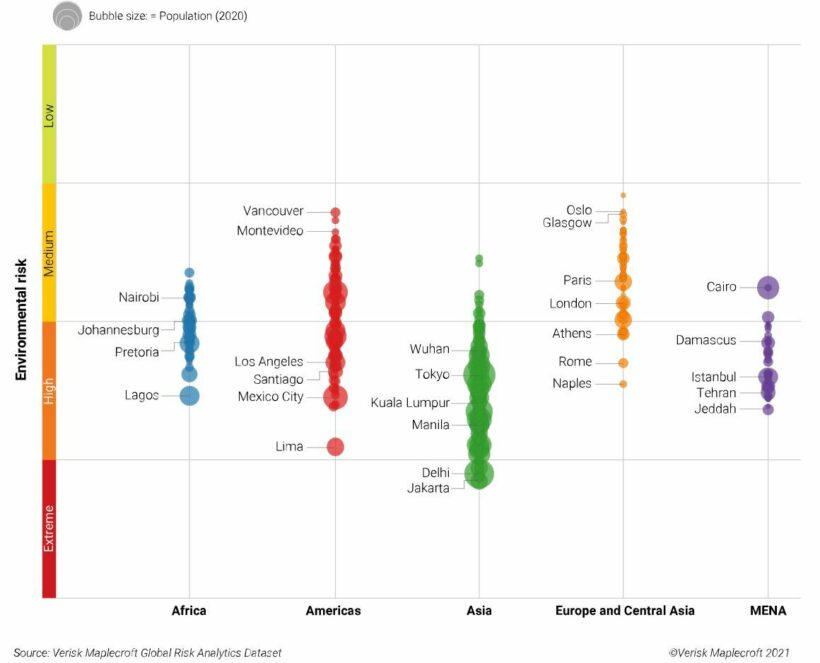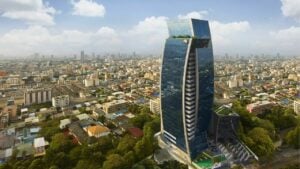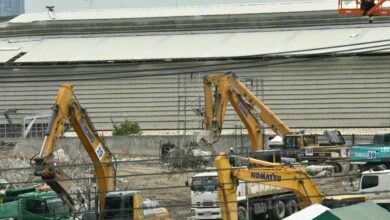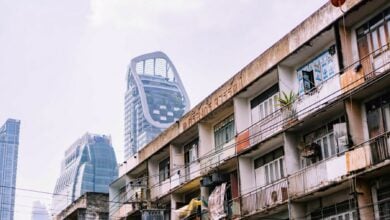Asia holds 99 of the 100 most environmentally at-risk cities

If you live in 1 of the 100 most environmentally vulnerable cities in the world, then unless you live in Lima, Peru, we can guess what continent you’re on. According to a recent risk assessment study, 99 out of the top 100 most environmentally vulnerable cities are located in Asia with 80% of them in India or China alone. 1.5 billion people in 400 large cities worldwide are considered to be at high or extreme risk. Natural disasters and climate change, heatwaves, water shortages, and pollution that shortens the average life span are amongst the environmental risks facing people today.
Cities hold more than half the world’s population and are the financial drivers of a country’s economy, but most cities will continue to suffer worse and worse air quality, pollution, extreme weather, water scarcity, and other natural hazards. Asian cities are hard hit, with Karachi ranked 12th, Manila 71st, and Bangkok holding the 84th spot on the list of cities at risk environmentally.
Holding the uncoveted top spot on the list is the Indonesian capital of Jakarta, with frequent heatwaves, flooding, and pollution only increasing. New Delhi ranked second, joined by other Indian cities such as Chennai in 3rd, Agra in 6th, Kanpur in 10th, Jaipur in 22nd, Lucknow in 24th, and Mumbai in 27th. In total, 13 of the top 20 at-risk cities on the list are in India.
Indian cities also fill the entire top 20 list of urban areas housing over a million inhabitants with the worst air quality, with New Delhi ranking first. Every year a million people die in India due to air pollution with 7 million total deaths globally. A lot of the air pollution issues stem from burning coal and other fossil fuels.
Turning from the skies to the water, China holds 35 of the top 50 cities with the most water pollution plus 13 of the top 15 water-stressed cities. There is hope that China’s emerging middle class will push for a higher quality of life, rallying for cleaner air and water and persuading the government to act more environmentally responsible.
China’s government seems to be beginning to act, shutting down factories until they meet emission goals and taking other strong steps. India has a less cohesive economy and a government with a looser grip on industry, putting it at a disadvantage in tackling environmental issues.
The Middle East and North Africa are the regions most at risk of environmentally calamitous events outside of Asia. Focusing on global warming, sub-Saharan Africa holds 40 of the 45 most at-risk cities. Abidjan, Brazzaville, Freetown, Kigali, Mombasa, Monrovia and other large cities are vulnerable. Lagos and Kinshasa are the two cities in Africa with the largest populations and are included in the list of threatened cities.
Africa is in the unenviable position of being the continent that contributes the least to global warming and climate change but will suffer the most from the results which will bring heatwaves, increasingly bad droughts, flooding and more powerful storms. Large portions of the continent are not nearly prepared enough to deal with the resulting environmental disasters.
To compile the list of risk assessment environmentally for cities, researchers at Verisk Maplecroft looked at human vulnerability, the danger of extreme natural events, and how well the country could adapt to environmental change. They evaluated the livability and operational capacity of a city including its real estate assets and investment potential. The full report can be seen here.
SOURCE: Yahoo
Latest Thailand News
Follow The Thaiger on Google News:
































